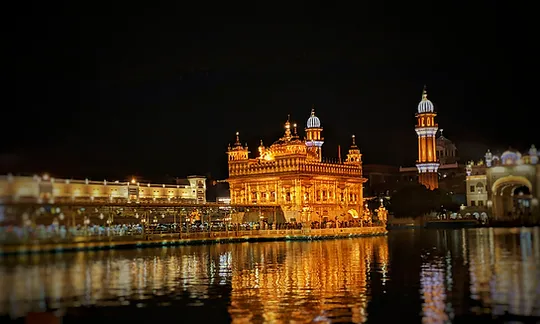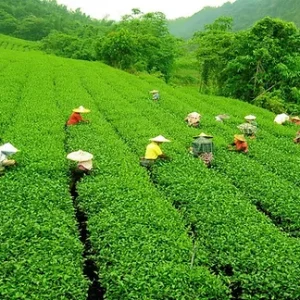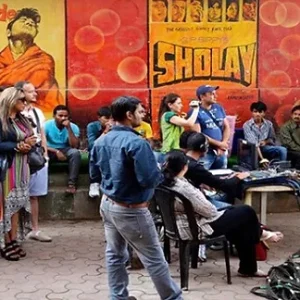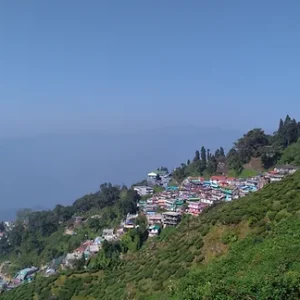Golden Temple Amritsar
- 2Nights/3Days
- Delhi – Amritsar – Delhi
Amritsar, literally meaning 'pool of nectar' is a beautiful city in the heart of the north Indian state of Punjab was founded by the fourth Guru of Sikhs, Guru Ram Das, 1534 - 1581, who had initially constructed a pool here. A flourishing city with significant religious centers and historical sites, Amritsar showcases a magnificent past, splendid present and a hopeful future. It bears the esteemed title of the jewel of Punjab.
A reservoir of national pride and religion, it is well-known throughout the world. Amritsar is known for its most famous temples is the "Harmandir Sahib" also known as the Golden Temple. The city is practically the synonym of the Sikh religion, each devout Sikh wishes to be sanctified with a pilgrimage to the city and to have a divine bath in the pool of nectar at the Golden Temple and It's a stunning complex with brilliant architecture and the history of the state is still alive in its library and on the lips of some old priests in the temple. It is also believed to be the site where Sage Valmiki wrote the epic, Ramayana. According to popular belief, Rama and Sita had spent a brief period of their 14 year exile here.
A visit to Amritsar is believed to purify the soul of the pilgrims. An incarnation of Sikh belief, the center of Punjab's political affairs, an aperture to the Gulf Countries, an attentive sentry at the Indo-Pak border, Amritsar embellishes an incredible and significant place in the Indian subcontinent. An emblem of confrontation against the British autocracy and the center of the Akali movements, Amritsar often bore the ferocious onslaught of the Muslim invader of medieval India. Amritsar is like a pastille with numerous features. The indispensable power of the city lies in its sparkling monuments, revered temples, beautiful shrines and most of all in its people, folk arts and the delicious cuisine. Amritsar occupied an unrivalled position in the business and commercial life of the undivided Punjab. Situated as it is on important trade routes, its trade even today extends to Kabul, Kashmir and Tibet, although the Partition left it a border town and did away with much of its erstwhile importance as a trade center.
The peaceful and serene ambience of the Golden Temple contrasts sharply with the disturbing sight of the bullet holes in Jallianwalah Bagh, which is where General Dyer conducted the infamous massacre in 1919. Some distance from Amritsar lies the Wagah border- a ceremonial outpost on the India - Pakistan border. Every evening, at sundown, soldiers of both countries put up a change of guard ceremony in which they bring down the national flags of their respective countries and briefly shake hands.An absolute must visit, the city of Amritsar is a vibrant mix of the soothing atmosphere of the Golden Temple, the disturbing bullet holes of Jallianwalah Bagh and the pageantry at Wagah Border.
Highlights:
1. Visit the spiritual and cultural centre of Sikh religion-Harmandir Sahib, more famously known as Golden Temple.
2. Go back to the history and explore Jallianwalah Bagh where the infamous massacre of hundreds of Indian took place in 1919.
3. Witness the "beating retreat border" ceremony at Wagah border.
Day 1 : Delhi - Amritsar (By train)
At New Delhi railway station, board the Shatabadi Express train to reach Amritsar. Tentative train timings are: - {7h20, 16h35}. Upon arrival, welcome on railway station and then transfer to hotel for Check-in. Evening are free at leisure or stroll free to walk around the local markets.
Overnight at hotel.
Day 2 : Amritsar
Breakfast at hotel.
After breakfast enjoy a day of sightseeing in this historic city of Amritsar. First, visit the beautiful Harmandir Sahib, also known as the Golden Temple. It is the spiritual and culture centre of the Sikh religion. The main shrine itself is made of marble and it stands in the middle of a picturesque body of water. The holy book of the Sikhs - the Guru Granth Sahib is housed in this peaceful and serene sanctum. Every morning these holy books are brought from the Akal Takht in a procession and returned back every night.
You might stay over at the temple to see this procession. The roof of the edifice is gold leafed, giving the temple its name. The structure inside the holy pool or 'Sarovar' is called the Hari Mandir. This 2-storeyed marble structure is said to be embossed with pure Gold. The way to this is a marbled path right through the middle of the 'Sarovar'. The Sarovar on all its sides is surrounded by the 'Parikrama' which houses the other buildings.
Guru ka Langar or the community kitchen is a prominent feature of anybody's visit to the temple - your visit is incomplete if you haven't eaten and participated in the community kitchen. The food is very basic with chapattis and Daal - but what is worth observing is the orderly way it is served in and consumed by anyone and everyone there. On an average about 25,000 people eat here and this increases manifold on occasions like "Gurpurab" and full moonlights. The Golden Temple complex is a treat to watch at night. The last prayers are done by 10 pm and on a full moon night one can marvel at its grandeur.
After that visit Jallianwala Bagh located within the city of Amritsar reminds us about the great tragedy and it evokes patriotic feeling in every Indian. A memorial to the hundreds of innocent Indians who were massacred by General Dyer in 1919. On April 13, thousands of people gathered in a peaceful assembly on the occasion of Baisakhi - a harvest festival - at the Jallianwala Bagh in the heart of Amritsar. When the crowds didn't disperse after warnings, Brigadier General Reginald Dyer, an officer of the British Indian Army, ordered his band of riflemen to open fire on the gathering, killing many. The firing lasted about 10 minutes and 1650 rounds were fired or 33 rounds per soldier. Official British Raj sources placed the fatalities at 379. According to private sources there were over 1000 deaths, with more than 2000 wounded and Civil Surgeon Dr. Smith indicated that there were 1,526. One can also witness the wall with gunshot marks. Jallianwala Bagh National Memorial Trust administrates the activities of this place. Located close to the Golden Temple, this garden is easily reachable and it is a must visit place in Amritsar.
Later visit the Durgiana Hindu temple which looks like a replica of the golden temple.
In the late Afternoon, we transfer you to the western most part of the city to watch the India - Pakistan border "Beating retreat border" ceremony at the Attari-Wagah border, the only border crossing between India and Pakistan. Wagah Border is situated at a distance of 28 kilometers from Amritsar.
At the entrance of this outpost, there is a sightseeing gate with a dedication "Swarna Jayanti". From this a panoramic view of the scenery is seen. There are electrified barriers with 66,000 volts of electric current.
The ceremony witnesses huge crowds from both sides of the border. Soldiers march towards the gate at the border, which is thrown open when they reach there. Soldiers on both sides of the gate salute each other and start lowering the flags. After this, the soldiers retrieve and fold the flags. The gate is closed on both sides of the border with a loud sound. Then a trumpet sounds towards the end of this entire ceremony. The soldiers return to their respective position with their country's flag.
Return to Amritsar & overnight at hotel
Day 3 : Amritsar - Delhi - Onward (By train)
Breakfast at hotel.
Check out from your hotel and transfer to Amritsar railway station to board your train to Delhi. Tentative train timings:- {05h10 & 17h00}.On arrival in Delhi internal transfer to onward destination with sweet memories of Amritsar tour.
1. Optional Delhi - Amritsar - Delhi flights also available for this tour
Best time to visit
2. Summer season in Amritsar: - summer in Amritsar starts in the month of April and lasts till June. The season is very hot and the temperature reaches up to 49 degrees Celsius. Travelers generally avoid this season because of the scorching heat.
3. Monsoon season in Amritsar: - July to October is the monsoon season. The city experiences mild to heavy rainfall during this season. It gives much relief to the people after the scorching heat of the summer. The moderate climate makes the weather cool and pleasant.
4. Winter season in Amritsar: - winter in Amritsar starts in November and lasts till March. The minimum temperature during this period is 4 degrees Celsius whereas the maximum reaches to 18 degrees Celsius. January is the coldest month of the season. This is the best time to visit Amritsar.
Suitable from:-
1. Amritsar by Train - There are many trains available from Delhi to Amritsar and from other major cities.
2. Amritsar by Air - Raja Sansi International Airport located in the city of Amritsar makes it possible for all to get regular flights all throughout the day. It connects the city with several important cities of the country as well as the world.
3. Flights from Delhi to Amritsar.
4. Flights from Chandigarh to Amritsar.
Maps
Photos
Cost Details
Hotels
3 star Hotels
Lorem Ipsum has been the industry’s standard dummy text ever since the 1500s, when an unknown printer took a galley of type and scrambled it to make a type specimen book. It has survived not only five centuries.
4 star Hotels
Lorem Ipsum has been the industry’s standard dummy text ever since the 1500s, when an unknown printer took a galley of type and scrambled it to make a type specimen book. It has survived not only five centuries.
Luxury Hotels
Lorem Ipsum has been the industry’s standard dummy text ever since the 1500s, when an unknown printer took a galley of type and scrambled it to make a type specimen book. It has survived not only five centuries.
Cars
Cedan
Lorem Ipsum has been the industry’s standard dummy text ever since the 1500s, when an unknown printer took a galley of type and scrambled it to make a type specimen book. It has survived not only five centuries.
SUVs
Lorem Ipsum has been the industry’s standard dummy text ever since the 1500s, when an unknown printer took a galley of type and scrambled it to make a type specimen book. It has survived not only five centuries.
Luxury
Lorem Ipsum has been the industry’s standard dummy text ever since the 1500s, when an unknown printer took a galley of type and scrambled it to make a type specimen book. It has survived not only five centuries.
Guide Details
Lorem Ipsum has been the industry’s standard dummy text ever since the 1500s, when an unknown printer took a galley of type and scrambled it to make a type specimen book. It has survived not only five centuries.
COST
₹50.00






Reviews
There are no reviews yet.